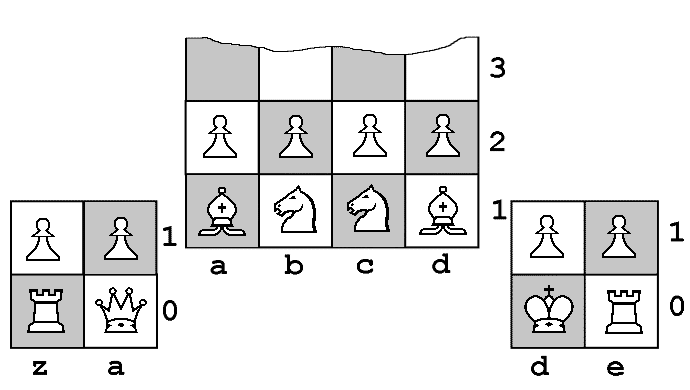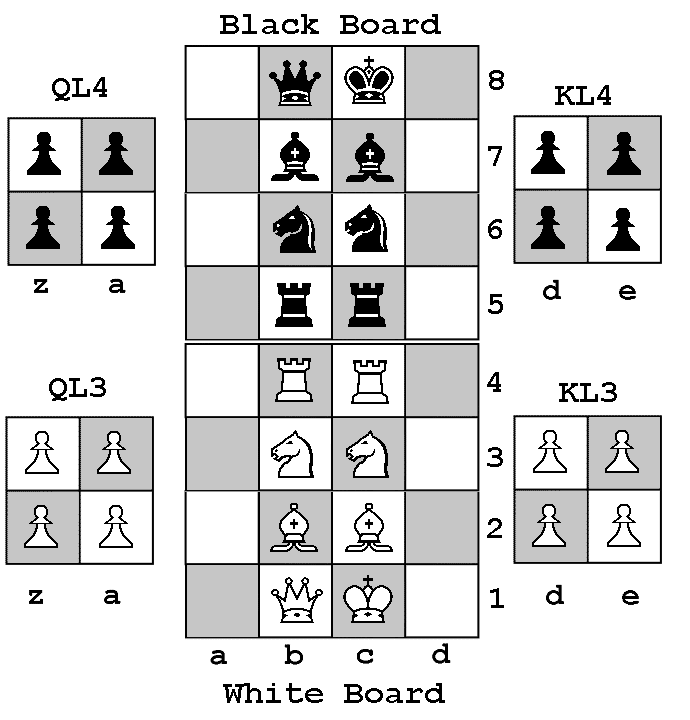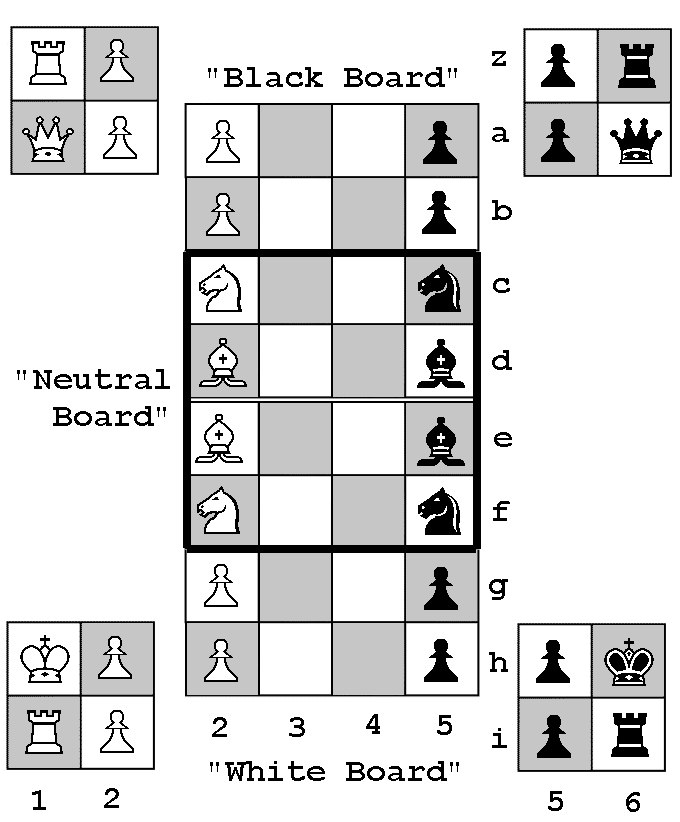 |
VARIANTS |
 |
 |
VARIANTS |
 |
As mentioned in the preface, in the meantime exists quite a variety of different versions for 3D-Chess. To list all variants would go beyond the scope of this page. In consequence I name here only some rules which can be easily addopted to the Tournament Rules for Three-Dimensional Chess or replace paragraphs without problem. Based on your personal preference you may combine different variants. But it is recommend to stay to "basic" rules for tournament purpose.
V.A1. Rook and King - Forced Mate - Variant by Ralph Peters
It seems like in "Tournament Rules" for STAR TREK 3D-Chess a single King can not be forced mate by an opponent Rook and King alone.
This is probably changed by modifying article 3.6. - the movement of attack boards:
Occupied attack boards can only move forward or to the side. Empty attack boards can only move backward or to the side.
V.A2. Rotating Attack Boards
It is possible to exchange the clear ('white') and coloured ('black') squares by rotating an attack board 180 degrees. This wouldn't change anything if an attack board is empty, but might be quite interesting if the attack board is occupied by one piece. So, the rule is:
An attack board occupied by one piece may be rotated 180 degrees.
This is especially interesting if that piece is a pawn on file z or e, as the rotation would 'free' that pawn without a 'side-move', which leads to the next variant.
V.A2.1. "Adjacent pin" means in reach of two squares
By this variant in contradiction to article 3.6.: "Adjacent pin" means in reach of two squares. Eg. adjacent pins for QL3 are QL2 or QL4 and QL1.
This makes side-moves impossible, which makes a combination with variant "V.A2." necessary.
V.A2.2. Upside-down Attack Boards
Some rules allow to rotate an empty attack board around the main board or let's say to put the attack board upside down.
This wouldn't have any effect in a game by Tournament rules, as long you don't put two attack boards at the "same" pin. So it is not recommend to use that rule with Tournament rules.
Nevertheless it might be quite interesting if the movement of the pieces is changed completely.
V.A3. Promote Pawn to Attack Board - Variant by Jens Meder
In this variant if a pawn promotes on a1, d1, a8 or d8, the player can choose an additional attack board instead of a piece.
This leads to five, six or more attack boards, which was shown in some episodes of STAR TREK.
V.A4. Six Attack Boards, No Waiting - Variant by Andrew Bartmess
There is also a known board variation using six attack boards. The two additional attack boards begin the game located attached to KL3 and QL4, and are refered to as "Neutral Attack Boards". They start the game as unclaimed attack boards, and cannot be moved by either side. The first player to move a chess piece onto either board takes possession of that attack board.
V.A5. Three Pins each Rule by Ken Dayson
Each player may move only its own two attack boards. Each attack board may move up or down one main board at a time, remaining on the same relative corner, when empty or occupied (only by one of the player's own paws if that pawn does not move backwards). Such limit each attack board to three pins, eg. QL1, QL3 and QL5.
V.M1. Real 3D
There exist quite some variants which should give the piece a more "real" 3D movement. For more information about that, please search the internet yourself.
V.P1. Exchange Bishops and Knights eg. by Jeremy Trylch
This enables the bishops to move out to the fourth rank on their initial move.

|
V.P2. King and Queen to the Center eg. by Larry L. Smith

|
V.P3. Another King and Queen to the Center eg. based on a variant by Franz Wurmser

|
V.P4. Unconventional Setup eg. by Larry L. Smith

|
V.P5. LEER 3D-Chess960 Rules LEER idea by Carsten Kullik / realization Jens Meder
V.P5.1.1 Chess960, previously known as "Fischer Random Chess", is a chess variant developed by Chess-Grandmaster Bobby Fischer with 960 different possible starting positions. The rules were presented for the first time in the year 1996. The World Chess Federation FIDE added the Chess960 Rules to its Laws of Chess as appendix F in the year 2009. Here you will get now a conversion for 3D-Chess.
V.P5.1.2 Before a Chess960 game a starting position is randomly set up, subject to certain rules. After this, the game is played in the same way as regular chess. In particular, pieces and pawns have their normal moves, and each player's objective is to checkmate the opponent's king.
V.P5.2. Starting position requirements
V.P5.2.1 The starting position for Chess960 must meet certain rules. White pawns are placed as in regular chess. Which means for 3D-Chess: z1QL, a1QL, a2W, b2W, c2W, d2W, d1KL and e1KL.
All remaining white pieces are placed randomly on the fields in front: z0QL, a0QL, a1W, b1W, c1W, d1W, d0KL and e0KL. But with the following restrictions:
a) The king is placed somewhere between the two rooks. Virtually the remaining fields function for that as one rank: d0KL and e0KL follow a1W, b1W, c1W, d1W; z0QL and a0QL are in advance.
b) The bishops are placed on opposite-colored squares.
V.P5.2.2 The black pieces are placed equal-and-opposite to the white pieces (or you could say symmetrical to the central axis).
V.S5.2.3 The starting position can be generated before the game either by a computer program or using dice, coin, cards, etc.
A possible procedure to place the pieces is as follows (it also explains well why there are 960 possible starting positions): There are 4 possible squares for each bishop; after their positioning you have 6 possiblities to place the queen, then 5 respectively 4 for the two knights. The rest is set, as the king has to be placed between the two rooks according to rule "V.P5.2.1 a)". If you could tell the difference between the two kinghts, you would have 4x4x6x5x4=1920 possible starting positions. As the knights appear the same, you have to divide that number by two which leads to the 960 variations.
V.P5.3. LEER 3D-Chess960 Castling Rules
V.P5.3.1 Chess960 allows each player to castle once per game, a move by potentially both the king and rook in a single move. However, a few interpretations of regular chess games rules are needed for castling, because the regular rules presume initial locations of the rook and king that are often not applicable in Chess960.
V.P5.3.2 After castling, the rook and king's final positions are exactly the same positions as they would be in standard chess.
Clarification:
Thus, after a-side castling (notated as O-O-O and known as queen-side castling in regular chess), the king is on an a-square (a0 for White and a9 for Black) and the rook is on a d-square (d0 for White and d9 for Black).
After e-side castling (notated as O-O and known as king-side castling in regular chess), the king is on an e-square (e0 for White and e9 for Black) and the rook is on a d-square (d0 for White and d9 for Black).
V.S5.3.3 How to castle
In Chess960, depending on the pre-castling position on the castling king and rook, the castling manoeuvre is performed by one of these four methods:
(a) Double-move castling: by on one turn making a move with the king and a move with the rook.
Example: The rooks are placed on the squares b1W and d1W, the king is placed on c1W. As well a-side as e-side castling are in this case a double-move castling.
(b) Transposition castling: by transposing the position of the king and the rook.
Example: The rooks are placed on the squares a0QL and e0KL, the king is placed on d0KL. As well a-side as e-side castling are in this case a transposition castling.
(c) King-move-only castling: by making only a move with the king.
Example: One rook is placed on the square d0KL, the king is placed on c1W. The e-side castling is in this case a king-move-only castling.
(d) Rook-move-only castling: by making only a move with the rook.
Example: One rook is placed on the square z0QL, the king is placed on a0QL. The a-side castling is in this case a rook-move-only castling.
V.P5.3.4
(a) All the squares between the king's initial and final squares (including the final square), and all of the squares between the rook's initial and final squares (including the final square), must be vacant except for the king and castling rook.
(b) Clarification:
If the king's and/or the castling rook's initial square is on rank "1", all of the other squares towards the final square must be vacant. A move within rank "0" isn't blocked by (own) pieces placed on rank "1".
Examples:
(1) The rooks are placed on the squares b1W and e0KL, the king is placed on d0KL: For a-side castling the squares c1W, d1W and a0QL have to be vacant, but not a1W. E-side castling is possible under the regulations of Tournament Rules for 3D-Chess article 3.5(a) without any futher restrictions.
(2) The rooks are placed on the squares b1W and e0KL, the king is placed on c1W: For a-side castling the squares a0QL, a1W, d1W and d0KL have to be vacant. For E-side castling he squares d1W and d0KL have to be vacant.
V.P5.3.5
In addition to the Tournament Rules for 3D-Chess article 3.5(a)(II)(2)[a] castling is also prevented for the time being, if the king's initial square is on rank "1" and one or more of the of the squares on rank "1" which it must cross, is attacked by one or more of the opponent's pieces.
V.P5.3.6 Recommendation
(a) When castling on a physical board with a human player, it is recommended that the king be moved outside the playing surface, the rook then be moved from its starting to ending position, and then the king be placed on his final square.
(b) To avoid any misunderstanding, it may be useful to state "I am about to castle" before castling.
V.P5.3.7 Notes
(a) In contradiction to the FIDE Laws of Chess it is illegal to castle as the first move (see Tournament Rules for 3D-Chess article 3.5(a)(II)(1)[a]).
(b) In some starting positions, the king or rook (but not both) do not move during castling. (Examples see above king-move-only or rook-move-only castling.)
V.P6. LEER 3D-Chess960x960=921.600 Rules LEER by Jens Meder
V.P6.1 This game is a further development of Chess960 (see above). In principle the rules are the same as in Chess960, but with the following exceptions:
a) The starting position isn't determined by luck but by each player's own will.
b) The starting positions of White and Black don't have to be mirror images of one another.
V.P6.2 At the beginning, the pawns are placed as usual. After that, White positions his first bishop. Black continues with his two bishops. Now White places his second bishop and one knight. Black positions both knights. Finally White places his queen which also defines the positions for the rooks and the king. Black follows. As usual, White has the first move.
V.P6.3 Based on these rules there are 960 multiplied by 960 different, possible starting positions, a total of 921.600. (960 diversities in 960 combinations)
V.P7. Board and Game-Play-Direction rotated by 90 degrees by Jens Meder
This starting position was invented during discussions about variants with more "real" 3D movemonet (compare V.M1.). The starting position might be usefull for such games.

|
Last Revision 8.DEC.2014
This is a non-profit fan publication. Use is purely for entertainment and NO infringement is intended! Star Trek; Star Trek: The Next Generation; Star Trek: Deep Space Nine and Star Trek: Voyager are registered trademarks of Paramount Pictures Corporation.